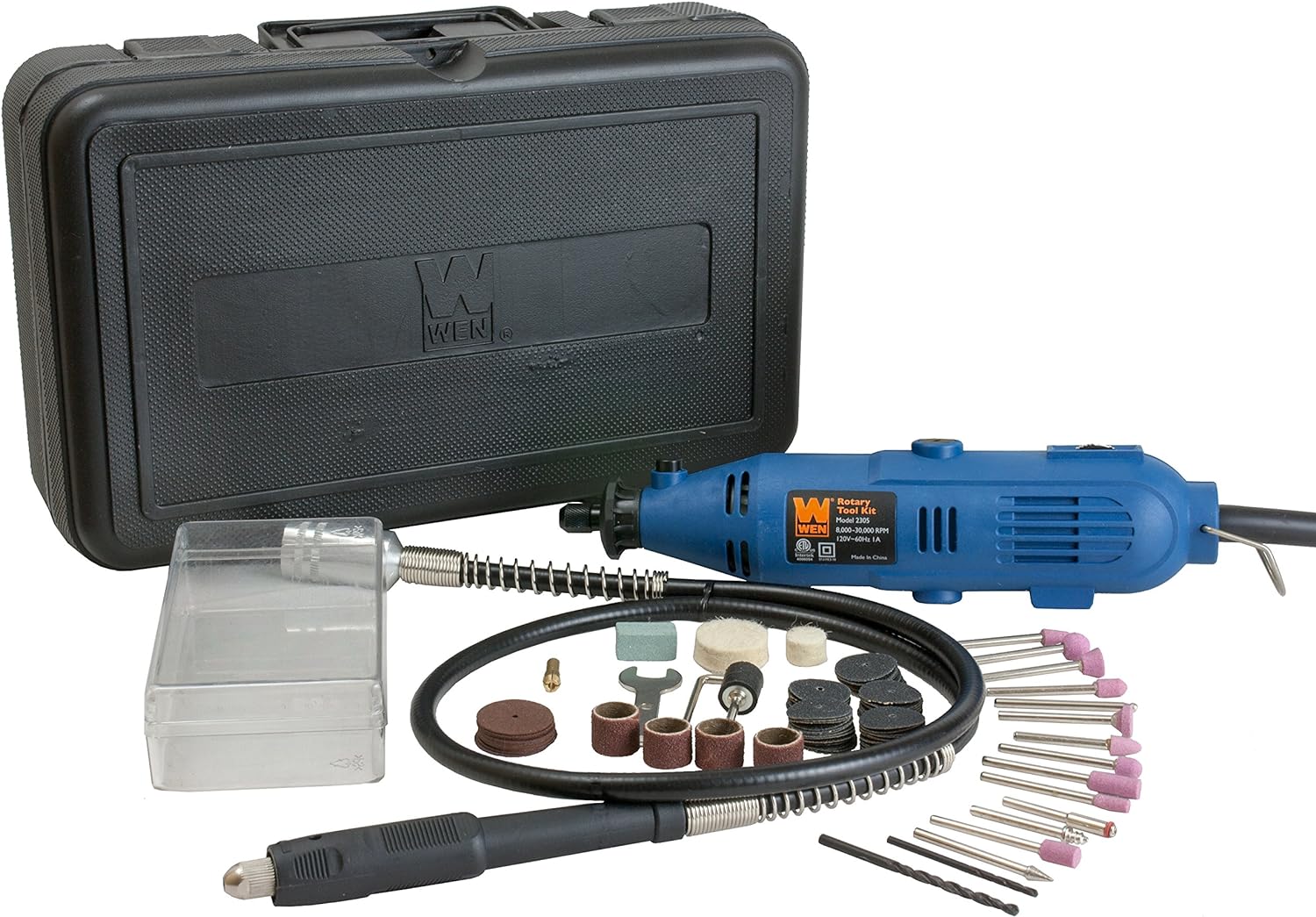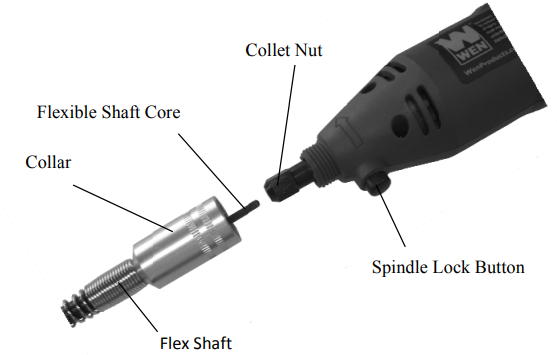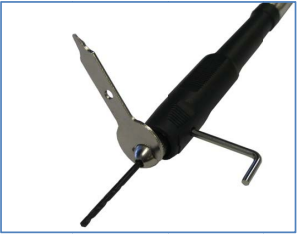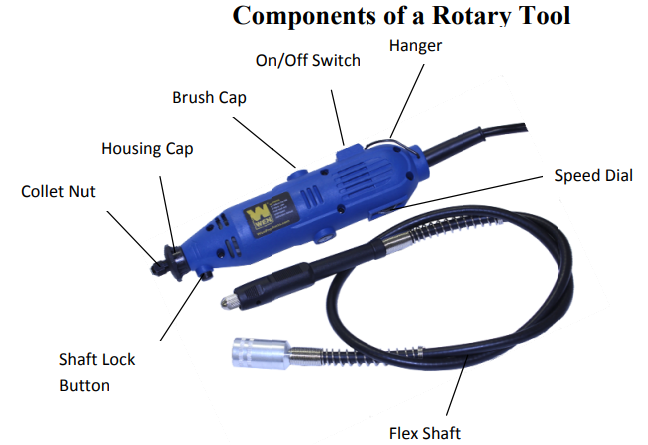How to Assemble: Wen Rotary Tool Set 2305 | Operating Instructions

Content

Introduction of WEN Rotary Tool Set 2305
WEN Rotary Tool Set 2305 is a versatile and powerful tool designed for various applications, including cutting, carving, engraving, sanding, grinding, and polishing. This set is perfect for DIY enthusiasts, hobbyists, and professionals who require a high-performance rotary tool for their projects. The WEN Rotary Tool Set 2305 is available for an estimated price of $49.95 and is now available for purchase.
Detailed Specifications
- Model: 2305
- Rating: 120V, 60Hz, AC only
- Input: 1.0 Amp
- No Load Speed: 8,000-30,000 RPM
- Collet Size: Supplied with 1/8" (3.2 mm) & 3/32" (2.3 mm)
- Weight: 1.1 lbs
Package Contents
- 1--Rotary Tool
- 1--Flex Shaft
- 1--Storage Case
Accessory Kit Contents
- 2-- Felt Polishing Wheels
- 2--- High Speed Cutters
- 10-- Grinding Stones
- 51-- Sanding Discs
- 1-- Dressing Stone
- 3-- Cut-Off Wheels
- 4-- Sander Bands
- 1-- Drum Sander
- 2-- Mandrels
- 2-- Drill Bits (1/8" & 3/32" Dia.)
- 2-- Collets (1/8" & 3/32") (3.2 & 2.3 mm)
- 1-- Bit Changing Spanner Wrench
Accessories
- Polishing wheels: Use to polish work-pieces made of metal and plastic. Use one of the provided mandrels to assemble.
- Diamond encrusted burrs: Available in many shapes, high speed cutters are used in carving, cutting and slotting in wood, plastics and soft metals such as aluminum, copper and brass. These are the accessories to use for freehand routing or carving in wood or plastic, and for precision cutting. Made of high quality steel. 1/8" shank
- Grinding stones: Use for surface treatment of metal parts, cast-metal parts, welding seams and for the removal of rust. Different shapes are available.
- Cutting-off wheels: Use to cut work-pieces made of metal, plastic, wood or stone. Use one of the provided mandrels to assemble. The cutting-off wheel only cuts with the outer edge.
- Dressing Stone: Use for cleaning and whetting grinding stones, if their surface has become irregular or dirty
- Drum Sander: Use to grind or smooth workpieces made of wood or glass fiber material. Use with the provided grinding drum.
- Mandrels: Shafts with screw or threaded head, which are designed for retaining grinding and polishing wheels.
Drill bits: Use for drilling holes in work-pieces made of plastic, wood or metal.

WEN Assembly
Warning: Always unplug Rotary Tool before changing accessories, changing collets or servicing your Rotary Tool.
- Collet nut
To loosen, first press Shaft Lock Button and rotate the shaft by hand until the lock engages the shaft preventing further rotation.
Caution: Do not engage lock while the Rotary Tool is running.
With the shaft lock engaged use the collet wrench to loosen the collet nut if necessary. The collet nut must be loosely threaded on when inserting an accessory. Change accessories by inserting the new one into the collet as far as possible to minimize runout and unbalance. With the shaft lock engaged, finger tighten the collet nut until the accessory shank is gripped by the collet. Avoid excessive tightening of the collet nut when there is no bit inserted. - Collets
Two different size collets to accommodate different shank sizes are available for your Rotary Tool. To install a different collet, remove the collet nut and remove the old collet. Insert the unslotted end of the collet in the hole in the end of the tool shaft. Replace collet nut on the shaft.
Caution: Always use the collet which matches the shank size of the accessory you plan to use. Never force a larger diameter shank into a collet.
Flex-shaft attachment
Warning: Read and understand the tool manual and these instructions for the use of this accessory with your tool. Failure to follow all instructions listed below may result in serious personal injury.
- Wear ANSI compliant eye protection. The operation of any power tool can result in foreign objects being thrown into the eyes.
- Do not operate the flexible shaft with a sharp or multiple bends. Over bending the shaft can generate excessive heat on the jacket or hand piece and may cause the flexible shaft to disengage from tool minimum recommended bend radius is 5”
- Always hold the hand piece firmly in your hands during the start-up. The reaction torque of the motor, as it accelerates to full speed, can cause the shaft to twist.
- Not for use with router bits or other large diameter cutting bits. Large diameter cutting bits can cause kickback and loss of control when used with the flexible shaft.
- Do not remove end ferrule while tool is running.
The cable will become loose from the jacket and will uncontrollably whip or lash around.
- Turn the tool off.
- Remove the housing cap from the tool.
- Press the Spindle Lock Button, unscrew the collet nut.
- Pass the end of the Flexible Shaft Core through the Collet Nut, and into the Collet. Note: it may be necessary to pull out a few inches of the core from the shaft housing. Depress the Spindle Lock, and hold it down while tightening the Collet Nut with the Wrench.
Attach by screwing the collar of the flex-shaft to the rotary tool.

Installing a bit in the flexible shaft
- Use the Round "L." Tool to prevent the Flexible Shaft Core from turning by inserting it into the hole in the side of the Flexible Shaft Handle.
- Once "L" Tool is in place, remove the Collet locking nut by turning it counterclockwise with the Wrench.
- Place the bit into the appropriate sized collet.
- Place the collet into the end of the Flexible Shaft Handle.
- Place the Collet Locking Nut over the bit, and tighten it by turning clockwise.
Tighten in place using the Wrench and the Round “L” Tool.

WEN Rotary Tool Set 2305 Operating Instructions
ON/OFF switch
- The on/off switch is located on the underside of the handle. It has two setting “0” (Off) and “I” (On).
- To switch on the tool, press the switch into the “I” (On) position. There is no need to hold it down as it will automatically lock in position.
- To switch the tool off, simply press the switch back into the “0” (Off) position.
- Always ensure that the switch is in the Off position before connecting the tool to the electric outlet. Always disconnect the tool from the electric outlet when not in use.
Operating speeds
To select the right speed for each job, use a practice piece of material.
NOTE: Speed is affected by voltage changes. A reduced incoming voltage will slow the RPM of the tool.
- Your tool is equipped with an internal electronic feedback system that provides a “soft start”, which will reduce the stresses that occur from a high torque start. The system also helps to keep the preselected speed virtually constant between no-load and load conditions.
- Your tool is equipped with a variable speed dial. The speed may be adjusted during operation by presetting the dial on or between any one of the settings.
- Certain materials, however, (some plastics and precious metals, for example) require a relatively slow speed because at high speed the friction of the accessory generates heat and may cause damage to the material.
- Slow speeds (15,000 RPM or less) usually are best for polishing operations employing the felt polishing accessories. They may also be best for working on delicate wood carving and fragile model parts. (All brushing applications require lower speeds to avoid wire discharge from the holder.)
- Higher speeds are better for carving, cutting, routing, shaping, cutting dadoes or rabbets in wood.
- Hardwoods, metals and glass require high speed operation, and drilling should also be done at high speeds.
- The point to remember is this: Many applications and accessories in our line will provide the best performance at full speed, but for certain materials, applications, and accessories, you need slower speeds, which is the reason our variable speed models are available.
- Ultimately, the best way to determine the correct speed for work on any material is to practice for a few minutes on a piece of scrap, even after referring to the chart. You can quickly learn that a slower or faster speed is more effective just by observing what happens as you make a pass or two at different speeds. When working with plastic, for example, start at a slow rate of speed and increase the speed until you observe that the plastic is melting at the point of contact. Then reduce the speed slightly to get the optimum working speed.
Some rules of thumb in regard to speed:
- Plastic and other materials that melt at low temperatures should be cut at low speeds.
- Polishing, buffing and cleaning with any type of bristle brush must be done at speeds not greater than 15,000 RPM to prevent damage to the brush.
- Wood should be cut at high speed.
- Iron or steel should be cut at high speed. If a high speed steel cutter starts to chatter — this normally means it is running too slow.
- Aluminum, copper alloys, lead alloys, zinc alloys and tin may be cut at various speeds, depending on the type of cutting being done. Use paraffin or other suitable lubricant on the cutter to prevent the cut material from adhering to the cutter teeth.
- Increasing the pressure on the tool is not the answer when it is not performing as you think it should. Perhaps you should be using a different accessory, and perhaps an adjustment in speed would solve the problem. Leaning on the tool does not help.
General Power Tool Safety Warnings
Read all safety warnings and all instructions. Failure to follow the warnings and instructions may result in electric shock, fire and/or serious injury.
Work area safety
- Keep work area clean and well lit. Cluttered or dark areas invite accidents.
- Do not operate power tools in explosive atmospheres, such as in the presence of flammable liquids, gases or dust. Power tools create sparks which may ignite the dust or fumes.
- Keep children and bystanders away while operating a power tool. Distractions can cause you to lose control.
Electrical safety
- Power tool plugs must match the outlet. Never modify the plug in any way. Do not use any adapter plugs with earthed (grounded) power tools. Unmodified plugs and matching outlets will reduce risk of electric shock.
- Avoid body contact with earthed or grounded surfaces such as pipes, radiators, ranges and refrigerators. There is an increased risk of electric shock if your body is earthed or grounded.
- Do not expose power tools to rain or wet conditions. Water entering a power tool will increase the risk of electric shock.
- Do not abuse the cord. Never use the cord for carrying, pulling or unplugging the power tool. Keep cord away from heat, oil, sharp edges or moving parts. Damaged or entangled cords increase the risk of electric shock.
- When operating a power tool outdoors, use an extension cord suitable for outdoor use. Use of a cord suitable for outdoor use reduces the risk of electric shock.
- If operating the power tool in damp locations is unavoidable, use a Ground Fault Circuit Interrupter (GFCI) protected supply. Use of an GFCI reduces the risk of electric shock.
Personal safety
- Stay alert, watch what you are doing and use common sense when operating a power tool. Do not use a power tool while you are tired or under the influence of drugs, alcohol or medication. A moment of inattention while operating power tools may result in serious personal injury.
- Use personal protective equipment. Always wear eye protection. Protective equipment such as dust mask, non-skid safety shoes, hard hat, or hearing protection used for appropriate conditions will reduce personal injuries.
- Prevent unintentional starting. Ensure the switch is in the off-position before connecting to power source and / or battery pack, picking up or carrying the tool. Carrying power tools with your finger on the switch or energizing power tools that have the switch on invites accidents.
- Remove any adjusting key or wrench before turning the power tool on. A wrench or a key left attached to a rotating part of the power tool may result in personal injury.
- Do not overreach. Keep proper footing and balance at all times. This enables better control of the power tool in unexpected situations.
- Dress properly. Do not wear loose clothing or jewelry. Keep your hair, clothing and gloves away from moving parts. Loose clothes, jewelry or long hair can be caught in moving parts.
- If devices are provided for the connection of dust extraction and collection facilities, ensure these are connected and properly used. Use of dust collection can reduce dust-related hazards.
Power tool use and care
- Do not force the power tool. Use the correct power tool for your application. The correct power tool will do the job better and safer at the rate for which it was designed.
- Do not use the power tool if the switch does not turn it on and off. Any power tool that cannot be controlled with the switch is dangerous and must be repaired.
- Disconnect the plug from the power source and/or the battery pack from the power tool before making any adjustments, changing accessories, or storing power tools. Such preventive safety measures reduce the risk of starting the power tool accidentally.
- Store idle power tools out of the reach of children and do not allow persons unfamiliar with the power tool or these instructions to operate the power tool. Power tools are dangerous in the hands of untrained users.
- Maintain power tools. Check for misalignment or binding of moving parts, breakage of parts and any other condition that may affect the power tool’s operation. If damaged, have the power tool repaired before use. Many accidents are caused by poorly maintained power tools.
- Keep cutting tools sharp and clean. Properly maintained cutting tools with sharp cutting edges are less likely to bind and are easier to control.
- Use the power tool, accessories and tool bits etc. in accordance with these instructions, taking into account the working conditions and the work to be performed. Use of the power tool for operations different from those intended could result in a hazardous situation.
Service
- Have your power tool serviced by a qualified repair person using only identical replacement parts. This will ensure that the safety of the power tool is maintained.
Safety Rules for Rotary Tools
- Hold power tool by insulated gripping surfaces, because the cutter may contact its own cord. Cutting a ”live” wire may make exposed metal parts of the power tool ”live” and shock the operator.
- Use clamps or another practical way to secure and support the workpiece to a stable platform. Holding the work by your hand or against the body leaves it unstable and may lead to loss of control.
- Accessories must be rated for at least the speed recommended on the tool warning label. Wheels and other accessories running over rated speed can fly apart and cause injury.
- If cutting into existing walls or other blind areas where electrical wiring may exist is unavoidable, disconnect all fuses or circuit breakers feeding this worksite.
- Do not operate the flexible shaft with a sharp bend. Over bending the shaft can generate excessive heat on the jacket or hand piece. The recommended minimum is 5" radius.
- Always disconnect the power cord from the power source before making any adjustments or attaching any accessories. You may unexpectedly cause the tool to start leading to serious personal injury.
- Be aware of the switch location, when placing the tool down or when picking the tool up. You may accidentally activate the switch.
- Always hold the hand piece firmly in your hands during the start-up. The reaction torque of the motor, as it accelerates to full speed, can cause the shaft to twist.
- Always wear safety goggles and dust mask. Use only in well ventilated area.
- Using personal safety devices and working in safe environment reduces risk of injury.
- After changing the bits or making any adjustments, make sure the collet nut and wrench/nose cap are both securely tightened. Loose adjustment devices can unexpectedly shift, causing loss of control, loose rotating components will be violently thrown.
- Do not reach in the area of the spinning bit. The proximity of the spinning bit to your hand may not always be obvious.
- Allow brushes to run at operating speed for at least one minute before using wheel.
- During this time no one is to stand in front or in line with the brush. Loose bristles or wires will be discharged during the run-in time.
- Carefully handle both the tool and individual grinding wheels to avoid chipping or cracking. Install a new wheel if tool is dropped while grinding. Do not use a wheel that may be damaged. Fragments from a wheel that bursts during operation will fly away at great velocity possibly striking you or bystanders.
- Never use dull or damaged bits. Sharp bits must be handled with care. Damaged bits can snap during use. Dull bits require more force to push the tool, possibly causing the bit to break.
- Use clamps to support workpiece whenever practical. Never hold a small workpiece in one hand and the tool in the other hand while in use. Allow for sufficient space, at least 6", between your hand and the spinning bit. Round material such as dowel rods, pipes or tubing have a tendency to roll while being cut, and may cause the bit to “bite” or jump toward you. Clamping a small workpiece allows you to use both hands to control the tool.
- Inspect your workpiece before cutting. When cutting irregularly shaped workpieces, plan your work so it will not slip and pinch the bit and be torn from your hand. For example, if carving wood, make sure there are no nails or foreign objects in the workpiece. Nails or foreign objects can cause the bit to jump.
- Never start the tool when the bit is engaged in the material. The bit cutting edge may grab the material causing loss of control of the cutter.
- Avoid bouncing the wheel, especially when working corners, sharp edges etc. This can cause loss of control and kick-back.
- The direction of feed with the bit into the material when carving, routing or cutting is very important. Always feed the bit into the material in the same direction as the cutting edge is exiting from the material (which is the same direction as the chips are thrown).
- Feeding the tool in the wrong direction, causes the cutting edge of the bit to climb out of the work and pull the tool in the direction of this feed.
- If the workpiece or bit becomes jammed or bogged down, turn the tool “OFF” by the switch. Wait for all moving parts to stop and unplug the tool, then work to free the jammed material. If the switch to the tool is left “ON” the tool could restart unexpectedly causing serious personal injury.
- Do not leave a running tool unattended, turn power off. Only when tool comes to a complete stop is it safe to put it down.
- Do not grind or sand near flammable materials. Sparks from the wheel could ignite these materials.
- Do not touch the bit or collet after use. After use the bit and collet are too hot to be touched by bare hands.
- Regularly clean the tool's air vents with compressed air. Excessive accumulation of powdered metal inside the motor housing may cause electrical failures.
- Do not allow familiarity gained from frequent use of your rotary tool to become commonplace. Always remember that a careless fraction of a second is sufficient to inflict severe injury.
- Do not alter or misuse tool. Any alteration or modification is a misuse and may result in serious personal injury.
- This product is not intended for use as a dental drill, in human or veterinary medical applications. Serious personal injury may result.
- When using the steel saws, cut off wheels, high speed cutters or tungsten carbide cutters, always have the work securely clamped. Never attempt to hold the work with one hand while using any of these accessories. The reason is that these wheels will grab if they become slightly canted in the groove, and can kick back causing loss of control resulting in serious injury. Your second hand should be used to steady and guide the hand holding the tool. When a cutoff wheel grabs, the wheel itself usually breaks. When the steel saw, high speed cutters or tungsten carbide cutter grab, it may jump from the groove and you could lose control of the tool.
Description
The WEN Rotary Tool Set 2305 is a must-have tool for any workshop. It has a lightweight and compact design, making it easy to handle and maneuver. The variable speed control allows you to adjust the RPM to match the task at hand, ensuring optimal performance and precision. The set includes a wide range of accessories for various applications, such as cutting metal, grinding welds, polishing jewelry, and engraving glass. The WEN Rotary Tool Set 2305 has a sturdy and durable construction that can withstand heavy-duty use, and it comes with a two-year warranty for peace of mind.
Setup Guide
To set up the WEN Rotary Tool Set 2305, follow these steps:
- Choose the appropriate accessory for your task and insert it into the collet.
- Tighten the collet by pressing the spindle lock button and turning the collet nut clockwise.
- Plug in the tool and select the desired speed setting using the speed dial.
- Press the on/off switch to turn on the tool and start working on your project.
Additional Safety Warnings
- GFCI and personal protection devices like electrician’s rubber gloves and footwear will further enhance your personal safety.
- Do not use AC only rated tools with a DC power supply. While the tool may appear to work, the electrical components of the AC rated tool are likely to fail and create a hazard to the operator.
- Keep handles dry, clean and free from oil and grease. Slippery hands cannot safely control the power tool.
- Develop a periodic maintenance schedule for your tool. When cleaning a tool be careful not to disassemble any portion of the tool since internal wires may be misplaced or pinched or safety guard return springs may be improperly mounted.
- Certain cleaning agents such as gasoline, carbon tetrachloride, ammonia, etc. may damage plastic parts.
WARNING: Risk of injury to user. The power cord must only be serviced by a WEN Service Facility. Some dust created by power sanding, sawing, grinding, drilling, and other construction activities contains chemicals known to cause cancer, birth defects or other reproductive harm. Some examples of these chemicals are:
- Lead from lead-based paints,
- Crystalline silica from bricks and cement and other masonry products, and
- Arsenic and chromium from chemically-treated lumber.
Your risk from these exposures varies, depending on how often you do this type of work. To reduce your exposure to these chemicals: work in a well ventilated area, and work with approved safety equipment, such as those dust masks that are specially designed to filter out microscopic particles.
Extension cords
WARNING: This tool is for indoor use only. Do not expose to rain or use in damp locations.
Make sure your extension cord is in good condition. When using an extension cord, be sure to use one heavy enough to carry the current your product will draw. An undersized cord will cause a drop in line voltage resulting in loss of power and overheating. The table below shows the correct size to be used according to cord length and nameplate ampere rating. If in doubt, use the next heavier gauge. The smaller the gauge number, the heavier the cord.
Minimum gauge for Extension Cords (AWG)
(When using 120V only)
Be sure your extension cord is properly wired and in good condition. Always replace a damaged extension cord or have it repaired by a qualified person before using it.
Ampere Rating | Total Length of Cord in feet | ||||
More Than | Not More Than | 25 | 50 | 100 | 150 |
0 | 6 | 18 | 16 | 16 | 14 |
6 | 10 | 18 | 16 | 14 | 12 |
10 | 12 | 16 | 16 | 14 | 12 |
12 | 16 | 14 | 12 | Not Recommended | |
Protect your extension cords from sharp objects, excessive heat and damp or wet areas. Use a separate electrical circuit for your tools. This circuit must not be less than a #12 wire and should be protected with a 15 A time-delayed fuse. Before connecting the motor to the power line, make sure the switch is in the OFF position and the electric current is rated the same as the current stamped on the motor nameplate. Running at a lower voltage will damage the motor.

WEN Maintenance
Service
Warning: Preventive maintenance performed by unauthorized personnel may result in misplacing of internal wires and components which could cause serious hazard. We recommend that all tool service be performed by a WEN Service Facility.
Warning: To avoid injury from unexpected starting or electrical shock, always remove plug from wall outlet before performing service or cleaning.
Carbon brushes
The brushes in your tool have been engineered for many hours of dependable service. In order to prepare your brushes for use, run your tool at full speed for 5 minutes under no load. This will properly “seat” your brushes, which extends the life of both your brushes and your tool. To maintain peak efficiency of the motor, we recommend every 40 - 50 hours the brushes be examined. Only genuine WEN replacement brushes specially designed for your tool should be used.
Cleaning
Warning: To avoid accidents always disconnect the tool from the power supply before cleaning or performing any maintenance. The tool may be cleaned most effectively with compressed dry air. Always wear safety goggles when cleaning tools with compressed air.
Ventilation openings and switch levers must be kept clean and free of foreign matter. Do not attempt to clean by inserting pointed objects through openings.
Caution: Certain cleaning agents and solvents damage plastic parts. Some of these are: gasoline, carbon tetrachloride, chlorinated cleaning solvents, ammonia and household detergents that contain ammonia.
Rotary Tool Set 2305 Troubleshooting
If you encounter any issues with the WEN, try these troubleshooting solutions:
- Power Issue: Check if the tool is properly plugged in, and the outlet is working. If the problem persists, contact WEN support.
- Overheating: Allow the tool to cool down before continuing the work. Ensure that you are using the appropriate accessories and speed settings for the task.
- Accessory Change: Make sure that the accessory is properly inserted and tightened. Use the spindle lock button for quick and easy changes.
- Vibration: Check if the accessory is damaged or worn out. Use a lower speed setting if necessary. Ensure that the tool is placed on a stable surface.
Warranty
ONE (1) YEAR WARRANTY OF WEN PRODUCTS FOR HOME USE. GREAT LAKES TECHNOLOGIES, LLC (“Seller") warrants to the original purchaser only, that all WEN consumer power tools will be free from defects in material or workmanship for a period of one (1) year from date of purchase. Ninety (90) days for all WEN Products, if the tool is used for professional or commercial use.
SELLER’S SOLE OBLIGATION AND YOUR EXCLUSIVE REMEDY under this One (1) Year Limited Warranty and, to the extent permitted by law, any warranty or condition implied by law, shall be the repair or replacement of parts, without charge, which are defective in material or workmanship and which have not been misused, carelessly handled, or mis repaired by persons other than Seller or Authorized Service Center.
Pros & Cons
Pros
- Powerful and versatile rotary tool
- Variable speed control
- Comfortable and ergonomic design
- Wide range of accessories included
- Flex shaft for precise and detailed work
Cons
- May be too loud for some users
- Some accessories may need to be purchased separately
- May overheat with prolonged use
Customer Reviews about WEN Rotary Tool Set 2305
Customers love the WEN Rotary Tool Set 2305 for its power and versatility. They appreciate the wide range of accessories included and the flexible shaft for detailed work. However, some customers complain about the noise level of the tool and the need to purchase additional accessories. Overall, customers are satisfied with the performance and quality of the WEN Rotary Tool Set 2305.
Faqs
What accessories come with my WEN 2305 Rotary Tool Kit?
What safety measures should I follow when using the WEN 2305 Rotary Tool?
How do I change the attachments on my WEN Rotary Tool Set 2305?
What are the safety guidelines for using the WEN Rotary Tool Set 2305?
Can I use the WEN Rotary Tool Set 2305 for wood carving?
How should I maintain my WEN Rotary Tool Set 2305?
How do I replace the motor brushes in the WEN Rotary Tool Set 2305?
How do I control the depth of cuts with the WEN Rotary Tool Set 2305?
How can I troubleshoot power issues with my WEN Rotary Tool Set 2305?
Where is Wood carving capabilities of the WEN Rotary Tool Set 2305?
Leave a Comment
